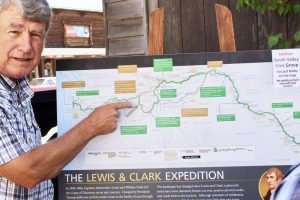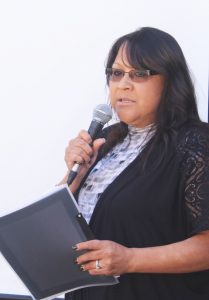
There’s no question about it. The South Valley Civic Group has put Darby on the map. The town shines like a precious gem on the latest map of the Lewis and Clark Trail on display at the second annual celebration of Sacajawea’s passage through the Darby area in 1807 with the Lewis and Clark Expedition. The celebration was held last week in the Sacajawea Rest Park in the heart of downtown Darby where a life-size bronze statue of Sacajawea carrying her infant son Jean Baptiste Charbonneau greets visitors as they enter the little pocket park.
Now, park visitors will also be greeted by over a dozen paintings, done by Darby High School advanced art students in Sean Byers’ class. The paintings, done on steel canvases, were made for outdoor display and have been permanently mounted at the park. The paintings depict animals, people and landscapes that may have been seen in the Darby area over the last 15,000 years.

Some of the animals depicted did roam the area at one time but have been extinct for thousands of years, like the saber tooth tiger, the wooly mammoth, and a large kind of buffalo twice the size of any modern buffalo. Then, there are the species that once thrived here and became extinct in North America but managed to survive elsewhere in the world, like the horse and the camel.
“If there is a horse being ridden by a person in one of these pictures, then we know it depicts an event in the last few hundred years,” said local author and Lewis and Clark Expedition “specialist,” Ted Hall. A few pictures, like the one with a logging truck in it or the one with a fly fisherman in it are probably things seen in only the last 100 years.
Another very “dated” picture was one depicting the area when it was under water. That’s at least about 12,000 years ago. Hall said that the statue of Sacajawea in the middle of the park sits at an elevation of about 4,000 feet above sea level. It is estimated that the water level in Glacial Lake Missoula, which extended up into the Bitterroot valley, reached 4,200 feet in elevation.
“That means that this Sacajawea statue would be 200 feet under water if the lake was filled again,” said Hall.

A featured speaker at the afternoon ceremony was Jami Pluff from the Flathead Indian reservation. Pluff is a member of the Confederated Salish and Kootenai Tribal Council’s Missing and Murdered Indigenous People Committee. She called it a “working group” formed to address the issue of missing and murdered people, especially women, on reservations across the nation.
Pluff read aloud the names of 19 people from the Flathead Reservation that are currently still missing or murdered. She said there are over a hundred more from other reservations around the state and thousands across the nation. She said figures from the Montana Department of Justice show 176 people currently missing in Montana. But if you look at the figures it shows that 30% of the missing are Native American women, when Native American women make up only 3% of the population.

This is just the missing, said, Pluff. She said it doesn’t account for the murdered.
“The research shows,” she said, “that women in Indian country are murdered at a rate that is 10 times the national average.” She said that 50% of Native American women report that they have been sexually abused or sexually assaulted.
“84% of Native American women have experienced violence in their lifetime,” she said.
“These are not just statistics,” said Pluff. “These are our mothers, our sisters, our aunts who are going missing and sometimes murdered.”
Pluff said that her working group’s mission was to bring this issue before the general public and try to stimulate awareness and action to address the issue. She said that research into the issue has uncovered a strong link between the missing and murdered issue and other violent crimes, drug use and sex trafficking. She said the working group’s aim was to develop a plan of action to address the issues. She said that the passage of Hannah’s Act has already helped some. With funds associated with the act they are hiring a missing persons specialist to collaborate with the Tribes, the State and the FBI in pursuing justice for the victims.
According to Pluff, young Native American women are especially vulnerable and criminal elements prey upon the most vulnerable.